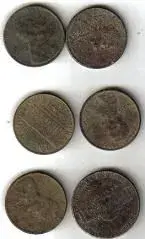If everything were equal you would expect the oldest coins to be the deepest and the newest coins to be the most shallow. But in the real world everything is not equal.
Soil conditions vary widely. A coin dropped in the Florida sand will get to 6" depth much quicker than a coin dropped in the red clay of Georgia. Weather conditions (rain, freeze/thaw cycles, etc.) are a factor in how quickly a coin descends through the soil. A flood can quickly remove or deposit several inches or several feet of soil.
Another factor is whether the soil has been disturbed. Plowing a field could deposit a freshly dropped 2005 Minnesota quarter 10" below the surface while bringing to the surface a long buried Colonial Copper. Yards, and especially gardens, may have been roto-tilled so anything buried within the zone that is disturbed will get relocated, maybe higher, maybe lower.
The size and mass of the coin is a factor. The larger the coin the more surface area and the more resistance the coin sees as it moves through the soil. The lighter the coin the less force (gravity) that pulls it downward.
There are many, many variables that determine how deep a coin will be in the soil. The thing to remember is the coins are where they are and our goal is to find them. Half the fun is trying to figure out why you found the 1964 nickel 2" below the 1941 Merc. (Maybe the nickel was dropped in 1964 and the Merc was dropped in 1966.)
Ours is not to ask why ... but where.




 HH omnicognic 8)
HH omnicognic 8) There are plenty of wheats still in circulation. Hec they hold up better than the darn Memorials. LOL Hey have you been back to the Plantation. Pm me if you want and let me know or all of us. HH
There are plenty of wheats still in circulation. Hec they hold up better than the darn Memorials. LOL Hey have you been back to the Plantation. Pm me if you want and let me know or all of us. HH